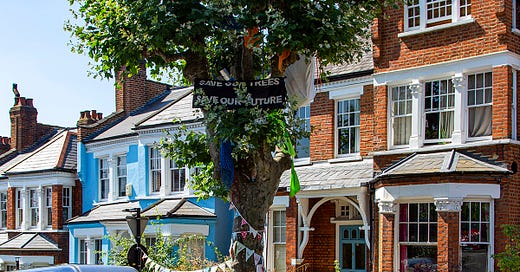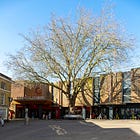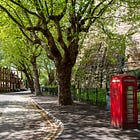79. Oakfield Road Plane
A condemned plane tree in North London is a pawn in an insurance saga.
One hundred and twenty years ago London planes were planted in vast numbers across the city, the tree on the corner of Oakfield and Quernmore Roads in Stroud Green is typical. When it was put in, planes had been planted at a feverish pace for thirty years already, and the planting would continue until the First World War slowed things down. Londoners can now breathe more easily thanks to the foresight of these Victorian and Edwardian planters, and today mature plane trees are a familiar sight across the city. But as the trees age, and the poor foundations of the houses thrown up speculatively before the introduction of building regulations start to subside, the trees often find themselves in the frontline.
On Oakfield Road in Stroud Green, the houses sell for significant sums and the old pollarded planes add to its leafy character. But the road is on a hill, and subsidence is damaging buildings. It is due to many factors, not least climate change which causes London’s sponge-like clay to expand and contract in concert with dry and wet conditions. With waves of unprecedented heat and biblical rainfall, this has become more pronounced in recent times.
Thirsty tree roots frequently get the blame for the problems of subsidence. There is little evidence to implicate the trees in many cases, but nevertheless, insurers demand the trees be removed in order to settle any claims. This is myopic in many ways: removing trees is likely to make the soil less stable, the character of the street will be diminished by the loss of mature trees, and removing trees with no proof they are the culprit reinforces an ill-informed view that tree roots will damage your house. Of course, trees can be the cause of subsidence, but the onus must be on the insurer to prove this, and the local authority who manages the trees must hold the insurers to account. If subsidence can be resolved with underpinning (fixing foundations so often hastily and shoddily constructed), without removing trees, then surely this is the outcome everyone wants.
The Oakfield Road Plane has become a focus for the debate around how we manage our buildings and our urban trees. It is due to be felled on Thursday this week, after protesters have managed to force many stays of execution. Local residents have been holding a vigil around the tree for months, and have even been sleeping in its canopy in a bid to prevent a Plymouth-type dawn raid.
As the day of reckoning approaches, there is still a chance that it can be saved. Even if it cannot be, the debate about how insurance companies are forcing the felling of mature street trees on dubious grounds is now a hot topic. The Haringey Tree Protectors put it thus: “corporations who blow green air about low carbon and climate targets but whose policies are gradually one-by-one, stealthily stripping our urban streets bare of these Victorian beauties”.
The campaigners have a crowdfunder to which you can contribute:
I wrote about this tree last year for London in Bits, you can read that article here:
Species details
London plane
Platanus x hispanica
Where to find it
Oakfield Road, London N4 4LD
///drives.lodge.shack | 51.576555, -0.109023
A long read about London planes
Over on my blog, thestreettree.com, I published a post earlier this year about London plane trees.












A great article. The implications of an insurance company win in this case are too awful to contemplate.
We have many streets lined with these beautiful trees in Westcliff/Leigh/Southend and they are pollarded every 3-5 years. I assume that helps to avoid sad situations like this.